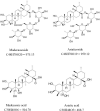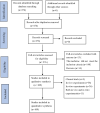Therapeutic Potential of Centella asiatica and Its Triterpenes: A Review
- PMID: 33013406
- PMCID: PMC7498642
- DOI: 10.3389/fphar.2020.568032
Therapeutic Potential of Centella asiatica and Its Triterpenes: A Review
Abstract
Centella asiatica (also known as Centella asiatica (L.) Urb. or Gotu kola) is a traditional Chinese medicine with extensive medicinal value, which is commonly used in Southeast Asian countries. This study aimed to summarize the effects of C. asiatica and its main components on neurological diseases, endocrine diseases, skin diseases, cardiovascular diseases, gastrointestinal diseases, immune diseases, and gynecological diseases, as well as potential molecular mechanisms, to study the pathological mechanism of these diseases based on the changes at the molecular level. The results showed that C. asiatica and its triterpenoids had extensive beneficial effects on neurological and skin diseases, which were confirmed through clinical studies. They exhibited anti-inflammatory, anti-oxidative stress, anti-apoptotic effects, and improvement in mitochondrial function. However, further clinical studies are urgently required due to the low level of evidence and lack of patients.
Keywords: Centella asiatica; anti-apoptosis; anti-inflammatory; anti-oxidative stress; triterpenoids.
Copyright © 2020 Sun, Wu, Wu, Zhang, Qin, Hayashi, Kudo, Gao and Liu.
Figures
Similar articles
-
Gotu Kola (Centella asiatica): Nutritional Properties and Plausible Health Benefits.Adv Food Nutr Res. 2015;76:125-57. doi: 10.1016/bs.afnr.2015.08.001. Epub 2015 Oct 1. Adv Food Nutr Res. 2015. PMID: 26602573 Review.
-
Cardiovascular Protective Effects of Centella asiatica and Its Triterpenes: A Review.Planta Med. 2019 Nov;85(16):1203-1215. doi: 10.1055/a-1008-6138. Epub 2019 Sep 20. Planta Med. 2019. PMID: 31539918 Review.
-
Ultrasound assisted extraction and quantification of targeted bioactive compounds of Centella asiatica (Gotu Kola) by UHPLC-MS/MS MRM tandem mass spectroscopy.Food Chem. 2022 Mar 1;371:131187. doi: 10.1016/j.foodchem.2021.131187. Epub 2021 Sep 20. Food Chem. 2022. PMID: 34592625
-
Protective effects of Centella asiatica leaf extract on dimethylnitrosamine‑induced liver injury in rats.Mol Med Rep. 2016 Nov;14(5):4521-4528. doi: 10.3892/mmr.2016.5809. Epub 2016 Oct 5. Mol Med Rep. 2016. PMID: 27748812 Free PMC article.
-
Centella asiatica (L.) Urban: From Traditional Medicine to Modern Medicine with Neuroprotective Potential.Evid Based Complement Alternat Med. 2012;2012:946259. doi: 10.1155/2012/946259. Epub 2012 May 14. Evid Based Complement Alternat Med. 2012. PMID: 22666298 Free PMC article.
Cited by
-
Uncovering the Anti-Angiogenic Mechanisms of Centella asiatica via Network Pharmacology and Experimental Validation.Molecules. 2024 Jan 11;29(2):362. doi: 10.3390/molecules29020362. Molecules. 2024. PMID: 38257275 Free PMC article.
-
Phytochemical screening, antioxidant activity of selected methanolic plant extracts and their detoxification capabilities against AFB1 toxicity.Heliyon. 2024 Jan 11;10(2):e24435. doi: 10.1016/j.heliyon.2024.e24435. eCollection 2024 Jan 30. Heliyon. 2024. PMID: 38312698 Free PMC article.
-
A Mini-Review on Solid Lipid Nanoparticles and Nanostructured Lipid Carriers: Topical Delivery of Phytochemicals for the Treatment of Acne Vulgaris.Molecules. 2022 May 27;27(11):3460. doi: 10.3390/molecules27113460. Molecules. 2022. PMID: 35684396 Free PMC article. Review.
-
Aromatic Plants as Potential Resources to Combat Osteoarthritis.Comb Chem High Throughput Screen. 2024;27(10):1434-1465. doi: 10.2174/0113862073267213231004094629. Comb Chem High Throughput Screen. 2024. PMID: 37861046 Review.
-
Peripheral Blood DNA Methylation Changes in Response to Centella asiatica Treatment in Aged Mice.Biology (Basel). 2025 Jan 10;14(1):52. doi: 10.3390/biology14010052. Biology (Basel). 2025. PMID: 39857283 Free PMC article.
References
-
- Ahmad Rather M., Justin-Thenmozhi A., Manivasagam T., Saravanababu C., Guillemin G. J., Essa M. M. (2019). Asiatic Acid Attenuated Aluminum Chloride-Induced Tau Pathology, Oxidative Stress and Apoptosis Via AKT/GSK-3β Signaling Pathway in Wistar Rats. Neurotox. Res. 35 (4), 955–968. 10.1007/s12640-019-9999-2 - DOI - PubMed
Publication types
LinkOut - more resources
Full Text Sources
Other Literature Sources




